Themed collection Chemical Communications HOT Articles 2022

Electrical bistability based on metal–organic frameworks
In this feature article, we focus on recent progress on MOF-based memristors and their switching mechanisms. In addition, challenges as well as future perspectives are discussed.
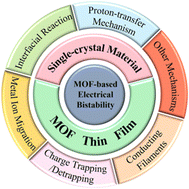
Chem. Commun., 2022,58, 9971-9978
https://doi.org/10.1039/D2CC03097G
Low-temperature reaction dynamics of paramagnetic species in the gas phase
By carefully controlling the reactants and precisely probing the products, we can gain insights into how radical reactions occur on a fundamental level.
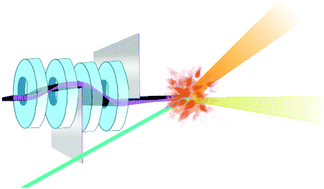
Chem. Commun., 2022,58, 3240-3254
https://doi.org/10.1039/D1CC06394D
Current electrochemical approaches to selective deuteration
A highlight of recent synthetic methods for selective deuteration of organic molecules using electrochemistry.
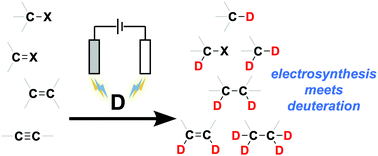
Chem. Commun., 2022,58, 2944-2953
https://doi.org/10.1039/D2CC00344A
Recent advances in electrocatalytic nitrite reduction
Electrocatalytic nitrite reduction is of great significance for wastewater treatment and value-added chemicals synthesis.
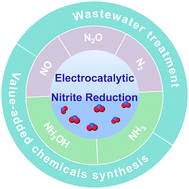
Chem. Commun., 2022,58, 2777-2787
https://doi.org/10.1039/D1CC06690K
Recent advances in radical enabled selective Csp3–F bond activation of multifluorinated compounds
The highlight describes the emerging trend in the C–F functionalization area: recent progress in the single-electron-transfer initiated selective defluorinative functionalizations of Csp3–F bonds in multifluorinated compounds via radical pathways.

Chem. Commun., 2022,58, 1066-1077
https://doi.org/10.1039/D1CC06446K
NMR methods for the analysis of mixtures
NMR spectroscopy is a powerful approach for the analysis of mixtures. This feature article describes a selection of methods that aim to address the complexity, the low concentrations, and the changing nature that mixtures can display.

Chem. Commun., 2022,58, 13855-13872
https://doi.org/10.1039/D2CC05053F
Fundamentals and applications of N-heterocyclic carbene functionalized gold surfaces and nanoparticles
Improved stability and higher degree of synthetic tunability has allowed N-heterocyclic carbenes to supplant thiols as ligands for gold surface functionalization. This review article summarizes the basic science and applications of NHCs on gold.
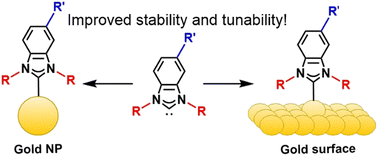
Chem. Commun., 2022,58, 13188-13197
https://doi.org/10.1039/D2CC05183D
De novo asymmetric Achmatowicz approach to oligosaccharide natural products
The development and application of the de novo asymmetric synthesis of oligosaccharides from achiral starting materials using the Achmatowicz reaction is reviewed.

Chem. Commun., 2022,58, 12913-12926
https://doi.org/10.1039/D2CC05280F
Ligand-ligated Ni–Al bimetallic catalysis for C–H and C–C bond activation
Ligand-ligated Ni–Al bimetallic catalysis not only affects electronic and steric property of substrates, but also produces strong directing effect for facile control of reactivity and selectivity in the activation of C–H and C–C bonds.

Chem. Commun., 2022,58, 12260-12273
https://doi.org/10.1039/D2CC04274F
Solid electrolytes for solid-state Li/Na–metal batteries: inorganic, composite and polymeric materials
This feature article presents the electrolyte synthetic approaches, design strategies, and merging materials that may address the critical issues of solid electrolytes for solid-state Li/Na–metal batteries.
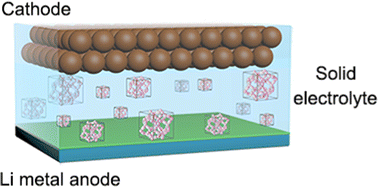
Chem. Commun., 2022,58, 12035-12045
https://doi.org/10.1039/D2CC04862K
Growth, replication and division enable evolution of coacervate protocells
In this Feature Article, we analyze how a minimal cell cycle of growth, replication of genetic information and division could be realized in coacervate protocells. This would allow such primitive cells to undergo evolution at the origins of life.

Chem. Commun., 2022,58, 11183-11200
https://doi.org/10.1039/D2CC03541C
Porous metal–organic frameworks for hydrogen storage
This article reviews the recent progress in the use of metal–organic frameworks as solid absorbents for hydrogen storage, and their current challenges and future prospects.
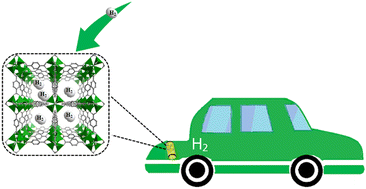
Chem. Commun., 2022,58, 11059-11078
https://doi.org/10.1039/D2CC04036K
Addressing big data challenges in mass spectrometry-based metabolomics
This work elaborates on a suite of bioinformatics solutions developed in the Huan lab to address big-data challenges in metabolomics.

Chem. Commun., 2022,58, 9979-9990
https://doi.org/10.1039/D2CC03598G
Transformation of metal–organic frameworks with retained networks
The designed strategies for producing MOF-derived porous materials with preserved characters (framework skeletons, surface areas, porosity and properties) and improved stability are outlined.
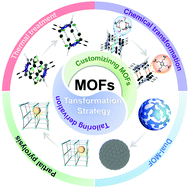
Chem. Commun., 2022,58, 8602-8613
https://doi.org/10.1039/D2CC02865D
Molecular interpretation of single-molecule force spectroscopy experiments with computational approaches
Single molecule force-spectroscopy techniques provide access to unprecedented molecular-scale details about biochemical and biological mechanisms.

Chem. Commun., 2022,58, 7110-7119
https://doi.org/10.1039/D2CC01350A
Gaining control over conjugated polymer morphology to improve the performance of organic electronics
Conjugated polymer (CP) microstructure plays a crucial role in determining the characteristics of a target device. Here, we provide an overview of the key aspects of the CP microstructure-property relationship carried out in our group.
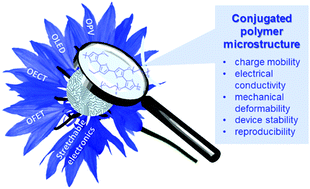
Chem. Commun., 2022,58, 6982-6997
https://doi.org/10.1039/D2CC01430K
Molecular polymer bottlebrushes in nanomedicine: therapeutic and diagnostic applications
Molecular polymer bottlebrushes offer a comprehensive toolbox for nanomaterials design. Their tuneable and multifunctional architecture has accelerated their use in nano-bio research and nanomedicine applications.
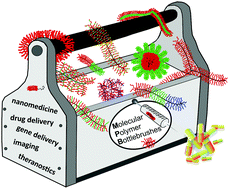
Chem. Commun., 2022,58, 5683-5716
https://doi.org/10.1039/D2CC01601J
Pushing the limits of nanopore transport performance by polymer functionalization
Inspired by the design and performance of biological pores, polymer functionalization of nanopores has emerged as an evolving field to advance transport performance within the last few years.

Chem. Commun., 2022,58, 5188-5204
https://doi.org/10.1039/D2CC01164F
Theory of electronic resonances: fundamental aspects and recent advances
The treatment of electronic resonances in terms of complex-valued energies is discussed with a focus on recent methodological developments.
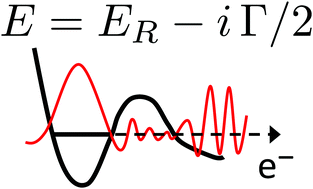
Chem. Commun., 2022,58, 5205-5224
https://doi.org/10.1039/D1CC07090H
Atomic force microscopy applied to interrogate nanoscale cellular chemistry and supramolecular bond dynamics for biomedical applications
Understanding biological interactions at a molecular-level grants valuable information relevant to improving medical treatments and outcomes.
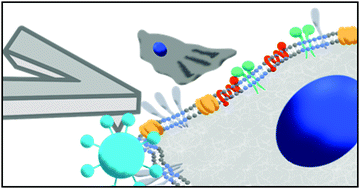
Chem. Commun., 2022,58, 5072-5087
https://doi.org/10.1039/D1CC07200E
Understanding the reactivity of frustrated Lewis pairs with the help of the activation strain model–energy decomposition analysis method
This Feature article presents recent representative applications of the combination of the Activation Strain Model of reactivity and the Energy Decomposition Analysis methods to understand the reactivity of Frustrated Lewis Pairs (FLPs).
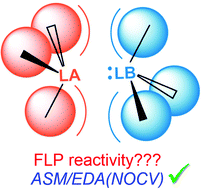
Chem. Commun., 2022,58, 4931-4940
https://doi.org/10.1039/D2CC00233G
Self-assembled organic and hybrid materials derived from oligo-(p-phenyleneethynylenes)
Self-assembly of oligo-(p-phenyleneethynylenes) (OPEs), a class of π-conjugated systems, into versatile materials has widened the application horizon of this molecular system with properties ranging from opto-electronics and energy to biology.
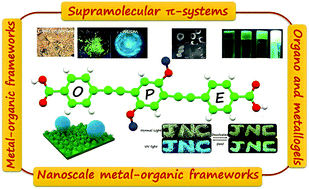
Chem. Commun., 2022,58, 4149-4167
https://doi.org/10.1039/D2CC00186A
Ionic liquids and deep eutectics as a transformative platform for the synthesis of nanomaterials
Ionic liquids and their siblings deep eutectic solvents offer a unique combinatorial toolbox enabling deliberate nanosynthesis like no other solvents.
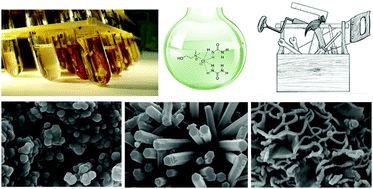
Chem. Commun., 2022,58, 3865-3892
https://doi.org/10.1039/D1CC06543B
Unlocking the computational design of metal–organic cages
Metal–organic cages are macrocyclic structures that can possess an intrinsic void for application in encapsulation, sensing and catalysis. In this article, we highlight approaches and limitations to their computational design.

Chem. Commun., 2022,58, 3717-3730
https://doi.org/10.1039/D2CC00532H
Sustainable catalysis with fluxional acridine-based PNP pincer complexes
The recent developments of sustainable catalytic reactions catalyzed by fluxional acridine-based PNP pincer complexes are explored, focusing on their unique structural features and reactivities compared to other traditional pincer complexes.
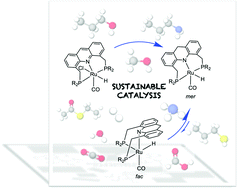
Chem. Commun., 2022,58, 3731-3746
https://doi.org/10.1039/D2CC00247G
Mechanophotonics – a guide to integrating microcrystals toward monolithic and hybrid all-organic photonic circuits
This feature article gives guidelines to construct molecular crystal-based organic photonic integrated circuits (OPICs) using mechanical micromanipulation with atomic force microscopy tips.
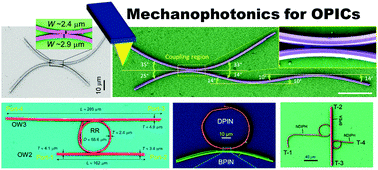
Chem. Commun., 2022,58, 3415-3428
https://doi.org/10.1039/D2CC00044J
Unlocking novel reaction pathways of diazoalkanes with visible light
In this feature article, the photolysis and dye-sensitized reactions of diazoalkanes are discussed and applications in organic synthesis are presented.

Chem. Commun., 2022,58, 2788-2798
https://doi.org/10.1039/D1CC06521A
Supramolecular cancer photoimmunotherapy based on precise peptide self-assembly design
Combinational photoimmunotherapy (PIT) is considered to be an ideal strategy for the treatment of malignant cancer, because it can ablate the primary tumor and induce the host immune response to control tumor growth and distal metastasis.

Chem. Commun., 2022,58, 2247-2258
https://doi.org/10.1039/D1CC06355C
Precise surface control of cathode materials for stable lithium-ion batteries
Precise surface control of cathode materials for stable Li-ion batteries: materials design, kinetics control and stabilization mechanism.

Chem. Commun., 2022,58, 1454-1467
https://doi.org/10.1039/D1CC06183F
In situ formation of inorganic healing overlayer for interface-stabilized all-inorganic CsPbIBr2 perovskite solar cells
A perovskite layer functionalized to be an outermost screen can strongly affect the capacity of the underlying device to avoid becoming decomposed under external stimuli, and subsequently affect the photovoltaic performance as well.
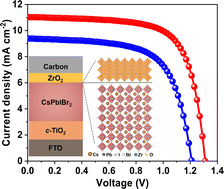
Chem. Commun., 2022,58, 13891-13894
https://doi.org/10.1039/D2CC05993B
Organocatalyst based cross-catalytic system
Small molecule-based cross-catalytic system that operates using principles of organocatalysis.

Chem. Commun., 2022,58, 13895-13898
https://doi.org/10.1039/D2CC05610K
Temperature driven charge transfer process in quantum confined two-dimensional Mn-doped CsPbBr3 perovskite nanoplatelets
Understanding of the energy/charge transfer processes in Mn–CsPbBr3 NPLs is achieved using temperature-dependent femtosecond TA spectroscopy. Charge transfer process which is efficient at 300 K is seen to be inhibited at 5 K.
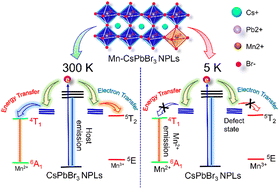
Chem. Commun., 2022,58, 13899-13902
https://doi.org/10.1039/D2CC05142G
An ‘AND’-based ratiometric fluorescence probe for the sequential detection of biothiols and hypochlorous acid
A novel ‘AND’-based ratiometric fluorescence probe for the sequential detection of biothiols and hypochlorous acid was developed, which exhibits fast response time and good selectivity in living cells.
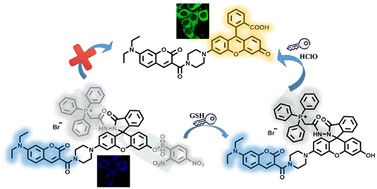
Chem. Commun., 2022,58, 13720-13723
https://doi.org/10.1039/D2CC05782D
The amphiphilic nanostructure of ionic liquids affects the dehydration of alcohols
The amphiphilic nanostructures of ionic liquids were found to have opposing effects on the rate of dehydration of secondary alcohols in the presence and absence of an added acid catalyst.
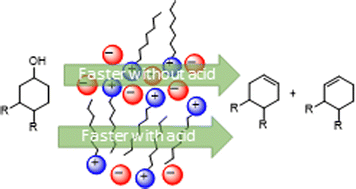
Chem. Commun., 2022,58, 13572-13575
https://doi.org/10.1039/D2CC04854J
Co/N-doped carbon nanospheres derived from an adenine-based metal organic framework enabled high-efficiency electrocatalytic nitrate reduction to ammonia
Co/N-doped carbon nanospheres act as a superb catalyst for ambient NH3 synthesis via electrochemical NO3− reduction, attaining a large NH3 yield of 758.0 μmol h−1 mgcat.−1 and a high faradaic efficiency of up to 96.5%.
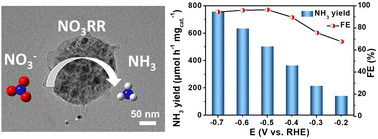
Chem. Commun., 2022,58, 13459-13462
https://doi.org/10.1039/D2CC05333K
Highly reversible Li metal anode using a binary alloy interface
A binary Ag–Zn alloy interface is designed to efficiently enhance the structural stability in keeping the high Li affinity of the alloy structure, and exhibits a great Li protective ability for a stable and durable Li metal anode.
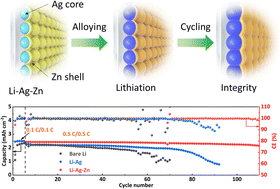
Chem. Commun., 2022,58, 13455-13458
https://doi.org/10.1039/D2CC05051J
A strained intramolecular P/Al-FLP and its reactivity toward allene
An intramolecular P/Al-based FLP with a biphenylene scaffold is synthesized by a convenient Al-Sn exchange. Despite the spacer the FLP functions interact leading to a strained compound, capable of CO2 binding and unprecedented allene activation.
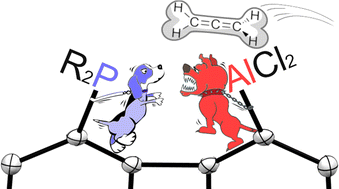
Chem. Commun., 2022,58, 13451-13454
https://doi.org/10.1039/D2CC05640B
A heteromultivalent host–guest sensor array for cell recognition and discrimination
Supramolecular heteromultivalent sensor arrays were constructed by coassembling different amphiphilic calixarenes and cyclodextrin, and applied in cell identification.
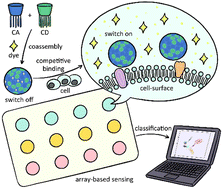
Chem. Commun., 2022,58, 13198-13201
https://doi.org/10.1039/D2CC04963E
Ketone-derived 2,3-dihydroquinazolinones in N-heteroarene C–H alkylation via C–C bond scission under oxidative metal catalysis
A mild silver-catalysed oxidative C–H alkylation of N-heteroarenes is developed, utilizing aliphatic ketone-derived 2,3-dihydroquinazolinones as an alkyl radical reservoir.
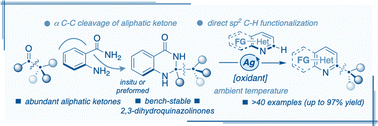
Chem. Commun., 2022,58, 13202-13205
https://doi.org/10.1039/D2CC04947C
Inversion of chirality in GTM-4 enantio-enriched zeolite driven by a minor change of the structure-directing agent
The replacement of an ethyl by a benzyl substituent in N-methyl-pseudoephedrine-derived chiral SDAs brings an astonishing inversion of chirality in the resulting -ITV zeolite framework, also leading to an increase of the enantioselective properties.

Chem. Commun., 2022,58, 13083-13086
https://doi.org/10.1039/D2CC04958A
Pillararene-functionalized rhodium nanoparticles for efficient catalytic reduction and photothermal sterilization
Pillar[5]arene-functionalized rhodium nanoparticles are prepared for catalytic reduction of toxic nitrophenols and azo dyes and efficient photothermal sterilization.
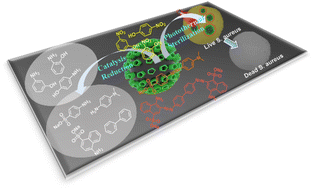
Chem. Commun., 2022,58, 13079-13082
https://doi.org/10.1039/D2CC05642A
E6C15 (E = Si–Pb): polycyclic aromatic compounds with three planar tetracoordinate carbons
A systematic exploration of the potential energy surface reveals two global minima with three planar tetra coordinate carbons (ptCs) and two global minima with three quasi-ptCs for E6C15 (E = Si–Pb) combinations.
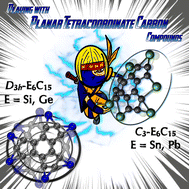
Chem. Commun., 2022,58, 13075-13078
https://doi.org/10.1039/D2CC04915E
Absolute configuration determination of SMTP-7 via microcrystal electron diffraction (MicroED)
The absolute configuration of a clinically important drug candidate, SMTP-7, with only micron-sized powders available, is directly obtained via microcrystal electron diffraction (MicroED) analysis.

Chem. Commun., 2022,58, 13071-13074
https://doi.org/10.1039/D2CC05218K
Dynamics of the alkyne → copper(I) interaction and its use in a heteroleptic four-component catalytic rotor
The dynamics of alkyne → copper(I) interactions has been determined and used to self-assemble a fast nanorotor, which underwent a self-catalyzed click transformation to a triazole rotor, an interesting process for the production of biohybrid devices.

Chem. Commun., 2022,58, 13019-13022
https://doi.org/10.1039/D2CC04497H
Mass photometry reveals SARS-CoV-2 spike stabilisation to impede ACE2 binding through altered conformational dynamics
Here we show using mass photometry how proline substitutions, commonly used for SARS-CoV-2 spike stabilisation in vaccine design, directly affects ACE2 receptor interactions via dynamics of open and closed states.
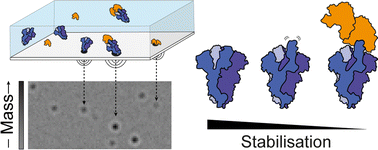
Chem. Commun., 2022,58, 12939-12942
https://doi.org/10.1039/D2CC04711J
A redox-active Mn(0) dicarbene metalloradical
A rare redox-active Mn(0) dicarbene anion with solvent-dependent electrochemical behaviour has been synthesized and thoroughly characterized.
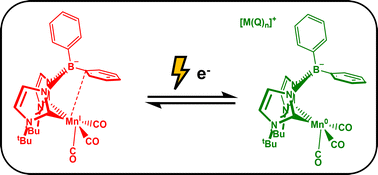
Chem. Commun., 2022,58, 12963-12966
https://doi.org/10.1039/D2CC04677F
Hierarchically mesoporous Ce-based MOFs with enhanced alkaline phosphatase-like activity for phosphorylated biomarker sensing
We developed a hierarchically mesoporous metal–organic framework nanozyme with enhanced alkaline phosphatase-mimicking activity for rapid and sensitive sensing of phosphorylated biomarkers.
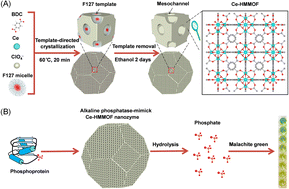
Chem. Commun., 2022,58, 12720-12723
https://doi.org/10.1039/D2CC04895G
Reductive activation of N2 using a calcium/potassium bimetallic system supported by an extremely bulky diamide ligand
Potassium reduction of a bulky diamido-calcium complex under an N2 atmosphere afforded the first well-defined, hetero-bimetallic s-block metal complex of activated dinitrogen.
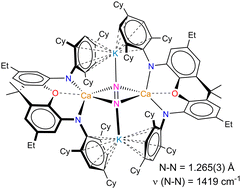
Chem. Commun., 2022,58, 12665-12668
https://doi.org/10.1039/D2CC04841H
A phosphine-based redox method for direct conjugation of disulfides
Redox-assisted Disulfide Direct Conjugation (RDDC) allows for disulfide functionalization under mild aqueous conditions without prior reduction.
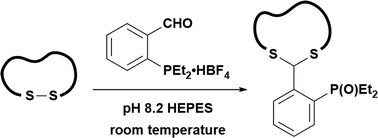
Chem. Commun., 2022,58, 12439-12442
https://doi.org/10.1039/D2CC04967H
One-pot synthesis of 3-trifluoromethylbenzo[b][1,4]oxazines from CF3-imidoyl sulfoxonium ylides with 2-bromophenols
A one-pot two-step fashion for the synthesis of 3-trifluoromethyl-1,4-benzoxazines from CF3-imidoyl sulfoxonium ylides and 2-bromophenols via lithium-bromide-promoted O–H insertion of sulfoxonium ylides and annulation has been demonstrated.
![Graphical abstract: One-pot synthesis of 3-trifluoromethylbenzo[b][1,4]oxazines from CF3-imidoyl sulfoxonium ylides with 2-bromophenols](/en/Image/Get?imageInfo.ImageType=GA&imageInfo.ImageIdentifier.ManuscriptID=D2CC04863A&imageInfo.ImageIdentifier.Year=2022)
Chem. Commun., 2022,58, 12443-12446
https://doi.org/10.1039/D2CC04863A
Synthesis and characterisation of an integratively self-sorted [Fe4L6]8+ tetrahedron
Exclusive formation of an integratively sorted tetrahedral complex enables incorporating a unique vertex.
![Graphical abstract: Synthesis and characterisation of an integratively self-sorted [Fe4L6]8+ tetrahedron](/en/Image/Get?imageInfo.ImageType=GA&imageInfo.ImageIdentifier.ManuscriptID=D2CC04624E&imageInfo.ImageIdentifier.Year=2022)
Chem. Commun., 2022,58, 12301-12304
https://doi.org/10.1039/D2CC04624E
Exploiting halido ligands to control nucleation pathways and Pt⋯Pt interactions in supramolecular co-polymerizations
We exploit halogen effects to tune metal–metal interactions, nucleation pathways and hetero-seeded growth in supramolecular copolymerizations.
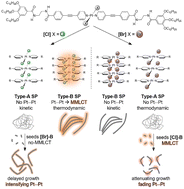
Chem. Commun., 2022,58, 12309-12312
https://doi.org/10.1039/D2CC04626A
Synthesis of highly crystalline imine-linked covalent organic frameworks via controlling monomer feeding rates in an open system
Covalent organic frameworks (COFs) have enormous potential in various applications because of their high crystallinity and superior surface area.
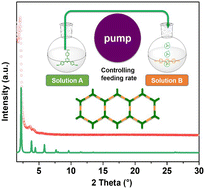
Chem. Commun., 2022,58, 12313-12316
https://doi.org/10.1039/D2CC04374B
Long-lived photoluminescence from an eight-coordinate zirconium(IV) complex with four 2-(2′-pyridyl)pyrrolide ligands
An eight-coordinate zirconium complex shows dual emission from ligand-to-metal excited states with long photoluminescence lifetime.
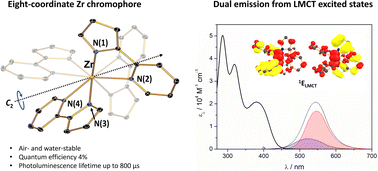
Chem. Commun., 2022,58, 11917-11920
https://doi.org/10.1039/D2CC04912K
Ligand non-innocence allows isolation of a neutral and terminal niobium nitride
A neutral and mononuclear niobium nitride complex (PNP)Nb![[triple bond, length as m-dash]](https://www.rsc.org/images/entities/char_e002.gif) N(N[tBu]Ar) (PNP− = N[2-PiPr2-4-methylphenyl]2) can be isolated using the redox-active properties of the [PNP]− ligand.
N(N[tBu]Ar) (PNP− = N[2-PiPr2-4-methylphenyl]2) can be isolated using the redox-active properties of the [PNP]− ligand.
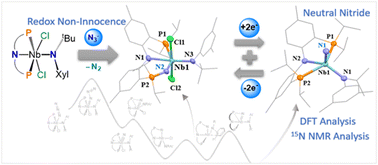
Chem. Commun., 2022,58, 11795-11798
https://doi.org/10.1039/D2CC04696B
Synthesis and characterization of a bimetallic americium(III) pyrithionate coordination complex
Pyrithione exhibits size-selective dimerization across the f-block. Experimental and computational analysis shows the Am complex contains greater covalency compared to the Nd analog.
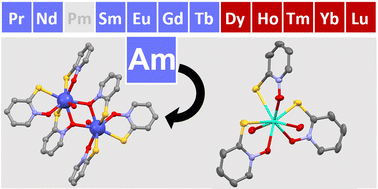
Chem. Commun., 2022,58, 11791-11794
https://doi.org/10.1039/D2CC03352F
Highly selective hydrogenation of dimethyl oxalate to methyl glycolate and ethylene glycol over an amino-assisted Ru-based catalyst
A Ru/NH2-MCM-41 catalyst was prepared via a coordination-assisted strategy for highly chemoselective hydrogenation of dimethyl oxalate to methyl glycolate (ca. 100%) and ethylene glycol (>90%) at low reaction temperature (343–433 K).
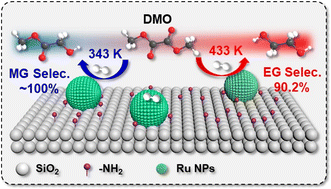
Chem. Commun., 2022,58, 11657-11660
https://doi.org/10.1039/D2CC03346A
Effect of the metal–support interaction in platinum anchoring on heteroatom-doped graphene for enhanced oxygen reduction reaction
The supporting material with an optimal structure not only changes the growth behavior but also tunes the electronic structure of the catalyst.

Chem. Commun., 2022,58, 11519-11522
https://doi.org/10.1039/D2CC03505G
Traceless enzymatic synthesis of monodispersed hypermodified oligodeoxyribonucleotide polymers from RNA templates
Monodispersed hypermodified polymers based on DNA scaffold displaying four different functional groups were synthesized through DNA polymerase catalyzed reverse transcription from RNA templates followed by RNase digestion.

Chem. Commun., 2022,58, 11248-11251
https://doi.org/10.1039/D2CC03588J
Quantitative U![[double bond, length as m-dash]](https://www.rsc.org/images/entities/char_e001.gif) O bond activation in uranyl complexes via silyl radical transfer
O bond activation in uranyl complexes via silyl radical transfer
Reductive silylation of the uranyl dication with 1,4-bis(trimethylsilyl)dihydropyrazine, or “Mashima's reagent”, is detailed.
![Graphical abstract: Quantitative U [[double bond, length as m-dash]] O bond activation in uranyl complexes via silyl radical transfer](/en/Image/Get?imageInfo.ImageType=GA&imageInfo.ImageIdentifier.ManuscriptID=D2CC04424B&imageInfo.ImageIdentifier.Year=2022)
Chem. Commun., 2022,58, 11244-11247
https://doi.org/10.1039/D2CC04424B
Guest-activated quaternary ammonium salt hosts emit room temperature phosphorescence
A host–guest system is constructed using quaternary ammonium salts as the hosts. It is the guest-activated hosts that emit room temperature phosphorescence, rather than the host-assisted guests in traditional doped systems.
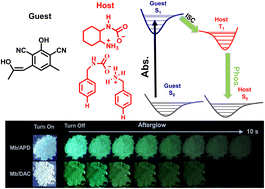
Chem. Commun., 2022,58, 11143-11146
https://doi.org/10.1039/D2CC04521D
Long life exceeding 10 000 cycles for aluminum-ion batteries based on an FeTe2@GO composite as the cathode
FeTe2@GO as a cathode for aluminum-ion batteries displays long-term cycling stability (10 000 cycles) at 1 A g−1, and a mechanism involving multiple cationic and anionic redox reaction was elucidated.
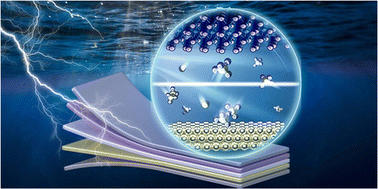
Chem. Commun., 2022,58, 10981-10984
https://doi.org/10.1039/D2CC04109J
An aryl diimine cobalt(I) catalyst for carbonyl hydrosilylation
Aldehyde and ketone hydrosilylation turnover frequencies of up to 330 s−1 have been achieved using a phosphine-substituted aryl diimine cobalt catalyst.
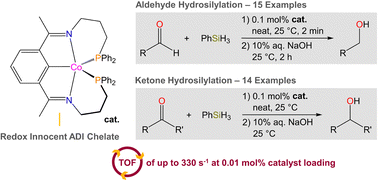
Chem. Commun., 2022,58, 10793-10796
https://doi.org/10.1039/D2CC04089A
Synthesis of the two isomers of heteroleptic Rh12L6L′6 metal–organic polyhedra by screening of complementary linkers
A series of porous, heteroleptic, rhodium-based trigonal antiprismatic metal–organic polyhedral was assembled, from which both possible isomers were identified via screening of complementary linkers.

Chem. Commun., 2022,58, 10480-10483
https://doi.org/10.1039/D2CC03220A
A book-like organic based electrode with high areal capacity for high performance flexible lithium/sodium-ion batteries
A free-standing multilayer book-like organic based electrode was prepared, presenting high conductivity and excellent flexibility, thereby achieving outstanding performance for flexible lithium-ion batteries and sodium-ion batteries.
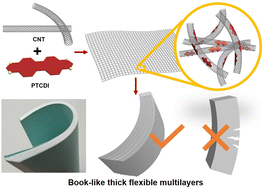
Chem. Commun., 2022,58, 10158-10161
https://doi.org/10.1039/D2CC03297J
Iron-catalyzed deconstructive alkylation through chlorine radical induced C–C single bond cleavage under visible light
A general method of iron-catalyzed deconstructive alkylation of alcohols with olefins through chlorine radical induced C–C single bond cleavage is developed.
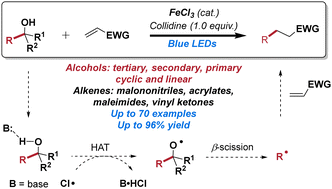
Chem. Commun., 2022,58, 9886-9889
https://doi.org/10.1039/D2CC03896J
An electron counting formula to explain and to predict hydrogenated and metallated borophenes
An electron counting rule for borophenes based on graphene and MgB2 helps to design metallated borophenes and borophanes, and suggests strategies to release 2D-borophenes from metal surfaces.
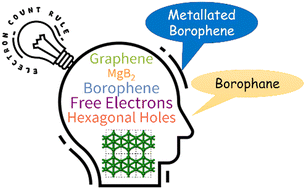
Chem. Commun., 2022,58, 9882-9885
https://doi.org/10.1039/D2CC03218J
Understanding and tackling the activity and selectivity issues for methane to methanol using single atom alloys
The process for the direct oxidation of methane to methanol is investigated on single atom alloys using density functional theory.
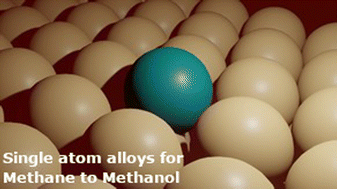
Chem. Commun., 2022,58, 9622-9625
https://doi.org/10.1039/D2CC03183C
Anionic or neutral? the charge of Ni8 cubes in metal–organic framework compounds
The cubic SBU Ni8X6L6 (X = OH−/H2O, L = ligand) in MOFs has so far been described as neutral in the literature. We investigated by detailed DRIFTS measurements and exchange reactions whether it shows anionic character, as observed in complexes.
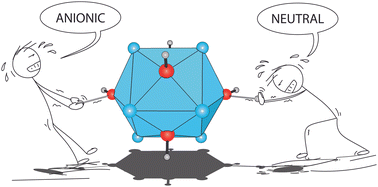
Chem. Commun., 2022,58, 9349-9352
https://doi.org/10.1039/D2CC03016K
Lithiophilic Sn–Co nano-seeds sealed in a hollow carbon shell to stabilize lithium metal anodes
A yolk–shell nanostructure with lithiophilic Sn–Co nano-seeds and a N-doped carbon shell is proposed to stabilize lithium nucleation and deposition.
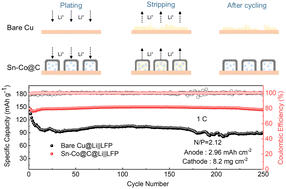
Chem. Commun., 2022,58, 9194-9197
https://doi.org/10.1039/D2CC02932D
About this collection
This ongoing web-collection features the latest articles published in ChemComm that have been marked as HOT by our Editors and trusted Reviewers. Congratulations to all those featured!